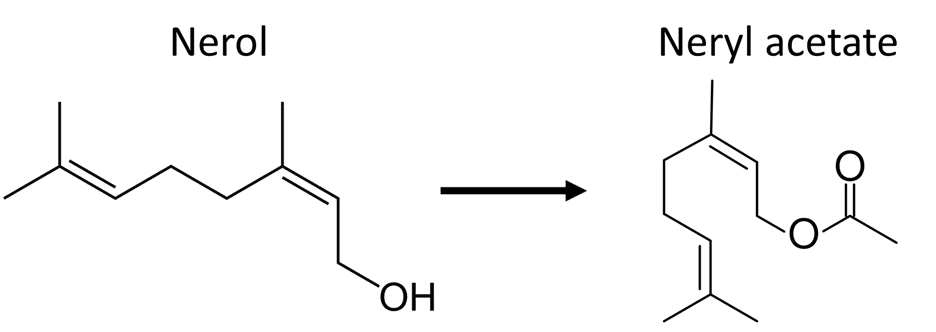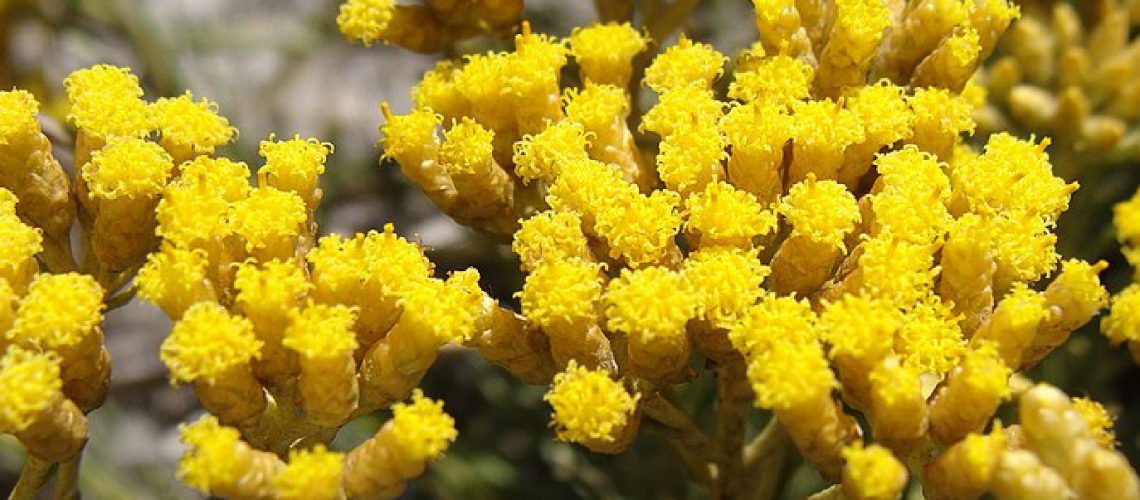Sunday, June 20th was the longest day of 2021, or in other words, the day filled with the most sunshine of the year. Naturally, we found it fitting to spotlight helichrysum, a flowering plant that earned its sunny name through its bright and enduring color.
The word helichrysum, pronounced in American English as heh-luh-kri-sm, is derived from the Greek words “helios” meaning sun and “chrysos” meaning gold. This is in reference to the golden color of many of the flowers from this botanical genus.
Originally native to Mediterranean areas, helichrysum has an extensive family tree; scientists have identified over 500 different species of helichrysum! Our 100% pure helichrysum oil is steam-distilled from flowers grown in Slovenia, a Central European country bordering Italy, Austria, Hungary, and Croatia.
An Oil of Mighty Metabolites
The two most common compounds in Nature’s Fusions Helichrysum essential oil are neryl acetate (34.98%) and gamma-Curcumene (15.02%) (fig. 1). Together they compose half of the oil’s chemical mixture, and both serve as natural metabolites in helichrysum plants.
Metabolites are the products of life-sustaining chemical reactions. For example, metabolites are made when a plant harnesses the power of the sun during photosynthesis. They’re also naturally produced when cells break down nutrients into usable building blocks for growth. Metabolites are even created as a helpful biproduct when a plant’s cell needs to remove or neutralize toxic materials.
It is fortunate for us that the metabolites that helichrysum produces in order to survive and grow are the same chemicals that help give it the fresh and woody scent in our essential oils.

Figure 1. Nerol is a common chemical found in flowering plants and grasses. Its chemical formula is C10H18O, and its scent is often compared to that of a rose. When nerol comes into contact with acetic acid inside the plant, it will react and produce neryl acetate, which has a chemical formula of C12H20O2. Neryl acetate is the most plentiful molecule in Nature’s Fusions Helichrysum Oil and has a distinctly different floral scent from nerol.
A Pleasant and Persistent Perfume
Helichrysum’s scent is sweet and flowery like a meadow breeze, yet strong and enduring like an Olympic athlete. It’s no surprise then that helichrysum flowers are sometimes called Immortelle or Everlastings, because the flowers retain their distinct yellow coloring even after drying out. We hope that once you give our Helichrysum Oil a try, your love for its honey-sweet scent will be everlasting too!

Some Common Companions
Not only is helichrysum known for it’s unique smell, it also has a multitude of uses. So pairing it with the extremely popular lavender is quite natural. They both work wonders for enhancing the appearance of aged, dry skin, calming, destressing, and more! Helichrysum also plays nicely with Bergamot, Citronella, Patchouli, and Pine. Remember though, helichrysum oil is very powerful, so it’s best to dilute it before topical use. If you’d like to apply it to your temples, cheeks, arms, or hands, we recommend a very small dilution. Just a 0.5% mixture of helichrysum oil with your favorite carrier oil and you’re good to go.
So pick up a bottle of Helichrysum and bring home the real sun flower.

